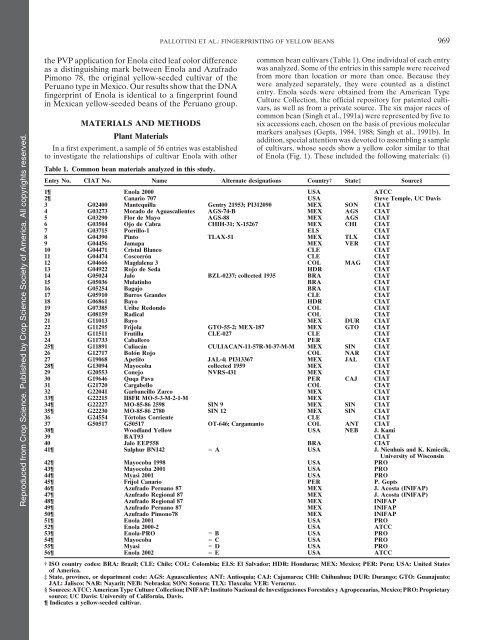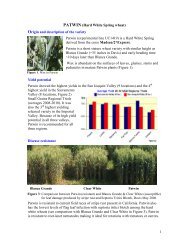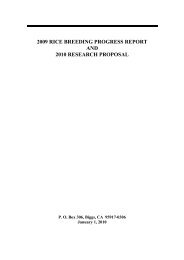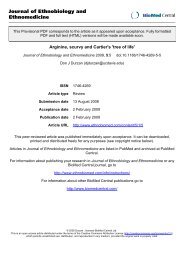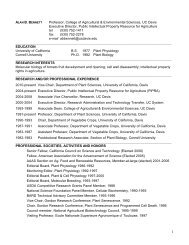plant genetic resources - Department of Plant Sciences - University ...
plant genetic resources - Department of Plant Sciences - University ...
plant genetic resources - Department of Plant Sciences - University ...
You also want an ePaper? Increase the reach of your titles
YUMPU automatically turns print PDFs into web optimized ePapers that Google loves.
Reproduced from Crop Science. Published by Crop Science Society <strong>of</strong> America. All copyrights reserved.<br />
PALLOTTINI ET AL.: FINGERPRINTING OF YELLOW BEANS 969<br />
the PVP application for Enola cited leaf color difference common bean cultivars (Table 1). One individual <strong>of</strong> each entry<br />
as a distinguishing mark between Enola and Azufrado was analyzed. Some <strong>of</strong> the entries in this sample were received<br />
Pimono 78, the original yellow-seeded cultivar <strong>of</strong> the<br />
Peruano type in Mexico. Our results show that the DNA<br />
fingerprint <strong>of</strong> Enola is identical to a fingerprint found<br />
in Mexican yellow-seeded beans <strong>of</strong> the Peruano group.<br />
from more than location or more than once. Because they<br />
were analyzed separately, they were counted as a distinct<br />
entry. Enola seeds were obtained from the American Type<br />
Culture Collection, the <strong>of</strong>ficial repository for patented culti-<br />
vars, as well as from a private source. The six major races <strong>of</strong><br />
common bean (Singh et al., 1991a) were represented by five to<br />
MATERIALS AND METHODS six accessions each, chosen on the basis <strong>of</strong> previous molecular<br />
<strong>Plant</strong> Materials<br />
markers analyses (Gepts, 1984, 1988; Singh et al., 1991b). In<br />
addition, special attention was devoted to assembling a sample<br />
In a first experiment, a sample <strong>of</strong> 56 entries was established <strong>of</strong> cultivars, whose seeds show a yellow color similar to that<br />
to investigate the relationships <strong>of</strong> cultivar Enola with other <strong>of</strong> Enola (Fig. 1). These included the following materials: (i)<br />
Table 1. Common bean materials analyzed in this study.<br />
Entry No. CIAT No. Name Alternate designations Country† State‡ Source§<br />
1 Enola 2000 USA ATCC<br />
2 Canario 707 USA Steve Temple, UC Davis<br />
3 G02400 Mantequilla Gentry 21953; PI312090 MEX SON CIAT<br />
4 G03273 Morado de Aguascalientes AGS-74-B MEX AGS CIAT<br />
5 G03290 Flor de Mayo AGS-88 MEX AGS CIAT<br />
6 G03504 Ojo de Cabra CHIH-31; X-15267 MEX CHI CIAT<br />
7 G03715 Porrillo-1 ELS CIAT<br />
8 G04390 Pinto TLAX-51 MEX TLX CIAT<br />
9 G04456 Jamapa MEX VER CIAT<br />
10 G04471 Cristal Blanco CLE CIAT<br />
11 G04474 Coscorrón CLE CIAT<br />
12 G04666 Magdalena 3 COL MAG CIAT<br />
13 G04922 Rojo de Seda HDR CIAT<br />
14 G05024 Jalo BZL-0237; collected 1935 BRA CIAT<br />
15 G05036 Mulatinho BRA CIAT<br />
16 G05254 Bagajo BRA CIAT<br />
17 G05910 Burros Grandes CLE CIAT<br />
18 G06861 Bayo HDR CIAT<br />
19 G07385 Uribe Redondo COL CIAT<br />
20 G08159 Radical COL CIAT<br />
21 G11013 Bayo MEX DUR CIAT<br />
22 G11295 Frijola GTO-55-2; MEX-187 MEX GTO CIAT<br />
23 G11511 Frutilla CLE-027 CLE CIAT<br />
24 G11733 Caballero PER CIAT<br />
25 G11891 Culiacán CULIACAN-11-57R-M-37-M-M MEX SIN CIAT<br />
26 G12717 Bolón Rojo COL NAR CIAT<br />
27 G19068 Apetito JAL-4; PI313367 MEX JAL CIAT<br />
28 G13094 Mayocoba collected 1959 MEX CIAT<br />
29 G20553 Conejo NVRS-431 MEX CIAT<br />
30 G19646 Quqa Pava PER CAJ CIAT<br />
31 G21720 Cargabello COL CIAT<br />
32 G22041 Garbancillo Zarco MEX CIAT<br />
33 G22215 II8FR MO-5-3-M-2-1-M MEX CIAT<br />
34 G22227 MO-85-86 2598 SIN 9 MEX SIN CIAT<br />
35 G22230 MO-85-86 2780 SIN 12 MEX SIN CIAT<br />
36 G24554 Tórtolas Corriente CLE CIAT<br />
37 G50517 G50517 OT-646; Cargamanto COL ANT CIAT<br />
38 Woodland Yellow USA NEB J. Kami<br />
39 BAT93 CIAT<br />
40 Jalo EEP558 BRA CIAT<br />
41 Sulphur BN142 � A USA J. Nienhuis and K. Kmiecik,<br />
<strong>University</strong> <strong>of</strong> Wisconsin<br />
42 Mayocoba 1998 USA PRO<br />
43 Mayocoba 2001 USA PRO<br />
44 Myasi 2001 USA PRO<br />
45 Frijol Canario PER P. Gepts<br />
46 Azufrado Peruano 87 MEX J. Acosta (INIFAP)<br />
47 Azufrado Regional 87 MEX J. Acosta (INIFAP)<br />
48 Azufrado Regional 87 MEX INIFAP<br />
49 Azufrado Peruano 87 MEX INIFAP<br />
50 Azufrado Pimono78 MEX INIFAP<br />
51 Enola 2001 USA PRO<br />
52 Enola 2000-2 USA ATCC<br />
53 Enola-PRO � B USA PRO<br />
54 Mayocoba � C USA PRO<br />
55 Myasi � D USA PRO<br />
56 Enola 2002 � E USA ATCC<br />
† ISO country codes: BRA: Brazil; CLE: Chile; COL: Colombia; ELS: El Salvador; HDR: Honduras; MEX: Mexico; PER: Peru; USA: United States<br />
<strong>of</strong> America.<br />
‡ State, province, or department code: AGS: Aguascalientes; ANT: Antioquia; CAJ: Cajamarca; CHI: Chihuahua; DUR: Durango; GTO: Guanajuato;<br />
JAL: Jalisco; NAR: Nayarit; NEB: Nebraska; SON: Sonora; TLX: Tlaxcala; VER: Veracruz.<br />
§ Sources: ATCC: American Type Culture Collection; INIFAP: Instituto Nacional de Investigaciones Forestales y Agropecuarias, Mexico; PRO: Proprietary<br />
source; UC Davis: <strong>University</strong> <strong>of</strong> California, Davis.<br />
Indicates a yellow-seeded cultivar.


